PERRY Cross knows exactly where he will take his first steps.
His second first steps.
He can see it as clearly as he can those last moments on his feet 24 years ago.
He recalls back in 1994, when he was just 19, seeing the bright blue sky, the green grass of the rugby field … and then feeling the pressure of the ruck that broke his neck.
He remembers his legs going out from under him. And then nothing.
He could still see the sky but he could feel nothing.
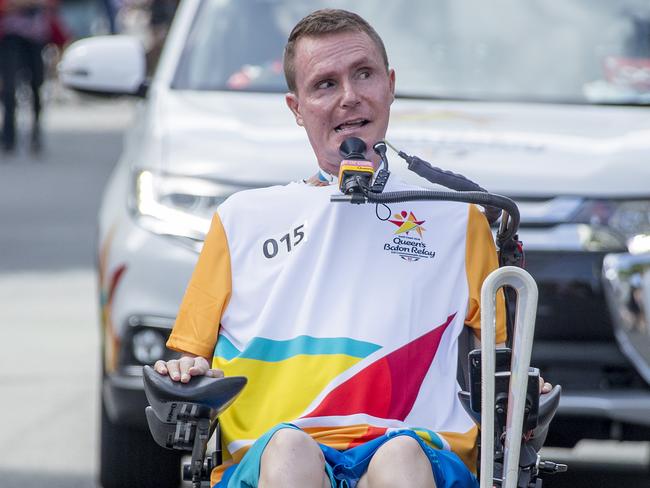
Nothing physically, anyway. Mentally, he already knew his old life was over.
Since that April day, Perry has been a C2 quadriplegic, both watching the world and changing it from his seat in a wheelchair.
He’s been around the world in his quest to find and fund a cure for paralysis. And now, it just might happen. Right here at home on the Gold Coast.
Which is exactly where he wants to be the day he gets back on his feet.
“I just want to feel the sand between my toes again,” he says.
“To be back on the beach … it’s what I dream of.

It’s a kind of torture to live somewhere as beautiful as the Gold Coast but to be apart from it.
GET A NEW SET OF HEADPHONES WITH YOUR DIGITAL SUBSCRIPTION
“I can see it, but I can’t touch it.
“To walk is the holy grail, but to feel … people forget that with paralysis comes the loss of sensation.
“I can’t feel anything except on my face. Not even the back of my head. There are a million things I wish I could do again, but feeling sand between my toes is the first thing I would do if I could.”
Judging by the look on his face, he’s pretty optimistic he will.
This is not the power of positive thinking, but of scientific prowess.
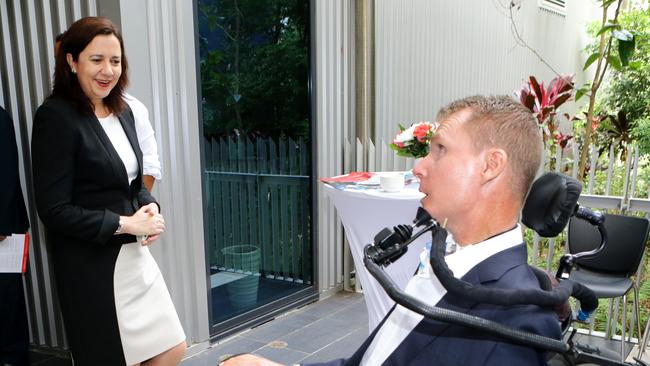
Thanks to Perry, in 2020 the Gold Coast is set to host the first human clinical trial in a bid to cure paralysis.
INTERVIEW ONE: KENTON CAMPBELL
INTERVIEW TWO: TRAVERS ‘CANDYMAN’ BEYNON
INTERVIEW THREE: JOHN WILLIAMSON
At his urging — and with the aid of funding from the Perry Cross Spinal Research Foundation that he founded in 2010 — the Griffith University Spinal Injury Project is undertaking groundbreaking research as part of a collaborative project begun with the Griffith Institute for Drug Discovery and the Menzies Health Institute Queensland.
Project head Professor James St John says the team is on track to develop a “nerve bridge” with a technique that involves transplanting cells from the nose into the spinal cord as a means to repair severed and damaged spinal cords.
“This is the real deal and it’s happening here,” says Perry.
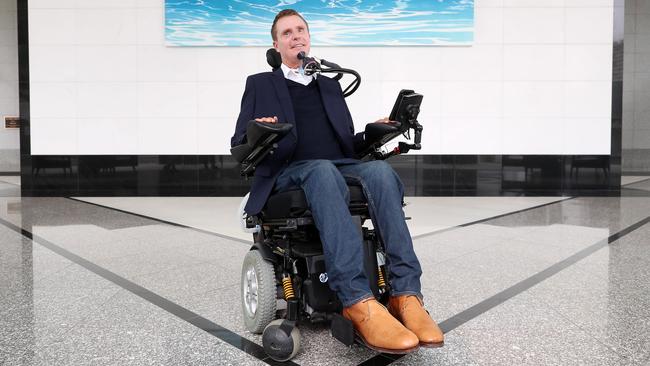
“I’ve been literally all over the world studying every technique and research out there and this is the best chance yet.
“I don’t think I’m being foolishly optimistic. I’m also not being unrealistic in my expectations. I’m obviously willing to be part of the human trial but there are a number of variables as to whether I would be selected.
“I think anyone with a spinal injury is watching this space. I’ve been talking with (former NRL player and quadriplegic) Alex McKinnon and he’s excited too.
“Even if it all works out, I don’t think I’m going to be running around.
“Flying started with the Wright brothers getting their aeroplane in the air for about 37 metres. That’s a long way from where we are now.
“If this trial works, it’s only our first flight.
“But I do believe that my life is about to change.”
The trial is being assisted by Griffith University Emeritus Professor Alan Mackay-Sim, named 2003 and 2017 Queenslander of the Year, whose work was crucial in the treatment of a Bulgarian man who in 2014 regained his ability to walk after undergoing a stem cell transplant.
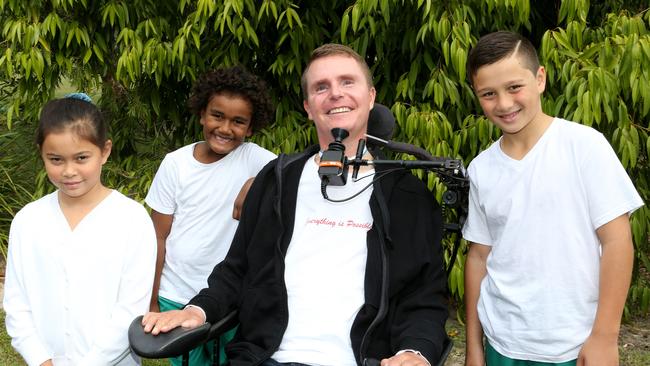
This trial, Perry grins, has legs.
In a situation in which no one could be blamed for crying, the 43-year-old chooses to laugh.
Yes, there have been many opportunities that have been born out of his disability — he’s been heralded by media worldwide as a tremendous role model for the human spirit in overcoming the odds, met countless celebrities, been awarded any number of accolades, truly made a difference to the world — but this path was never his choice.
Given someone in his physical position was not expected to survive two years, let alone thrive for 24 and counting, Perry is well versed in accentuating the positive.
“What are you going to do? Shit happens,” he says.
“I’m still here and I find the light and laughter wherever I can. It’s not always easy, but every single person has their own sorrow and their own burden. I’m not special.”
Perry says back in his schooldays at TSS, he was always the class clown. He loved speech and drama and didn’t mind the limelight.
This perhaps explains his decision to dress as Elvis, complete with white rhinestone onesie, at his 40th birthday party.
It was also this ability, this talent, which enables him to communicate so effectively on behalf of the disabled community.
But he admits it’s also a mother who “kicked my arse’’ that made him become a modern-day crusader.
“As soon as the accident happened, I just started on a mission to find sense in it, I guess,” he says.
“There were dark days — and there still are — but I got through them.
“Once I couldn’t use my body any more, I knew I had to use my mind. Next thing I’ve graduated from Bond University.
“I’ve just kept going. The other alternative is not an option. I think, too, when (Hollywood actor) Christopher Reeve died, I knew I had to step up, so to speak. I had to carry on the work he started.’’
Reeve was best known as the star of the Superman movies. In 1995 he was paralysed when he fell in a horseriding accident, and later became a high-profile advocate for people with spinal injuries. He died in 2004.

“His death was a reminder that my life is always tenuous. Every day is a risk, and that’s why I have to make it count,’’ Perry says.
“I’ve been so lucky to have my friends and my family. I’m surrounded by incredible people who have helped me physically, emotionally, financially. The love I have been given is the silver-lining of the accident.”
Perry says his disability was a factor in the breakup of his marriage to legendary marathon swimmer Susie Maroney. The couple separated last year, less than 12 months after marrying.
He says being based in different cities made it impossible to stay together.
“It was just too hard in the end,” he says.
“I’m not alone in having a marriage not work out. But that doesn’t mean it’s not hard.
“I still keep in touch with Susie, although not often.
“I would love to find love again but for now I’m focusing on the work the foundation is doing. It’s the reason I get up in the morning.”
And there’s another lesson in gratitude.
“Getting up in the morning’’ takes two hours and a team of social workers for Perry. It’s the same process every night.

And then there’s the matter of where his bed is based.
If you think finding a home on the Gold Coast is difficult, try being based in a wheelchair.
“When you’re disabled, it’s not so much finding a home as building one,” says Perry.
“My office is in Surfers Paradise, and my family are on Chevron Island and Benowa so I need to stay central but it’s not easy or affordable to get a block of land in those suburbs.
“When you’re disabled it’s so important to stay connected to your community. If I end up somewhere in whoop-whoop, the isolation would be intense.
“But I have to find somewhere or else I’m going to end up under the Isle of Capri bridge — which is at least accessible.
“I’ve considered a modified high-rise apartment as well but not only are they not cheap but I also have a 30kg black Labrador that would make that a bit difficult.”
Perry says while he is currently living with his brother, the time has come to move on.
He says his injury has placed huge strain on his family and he wants to give them space to move on with their own lives — as well as his own.
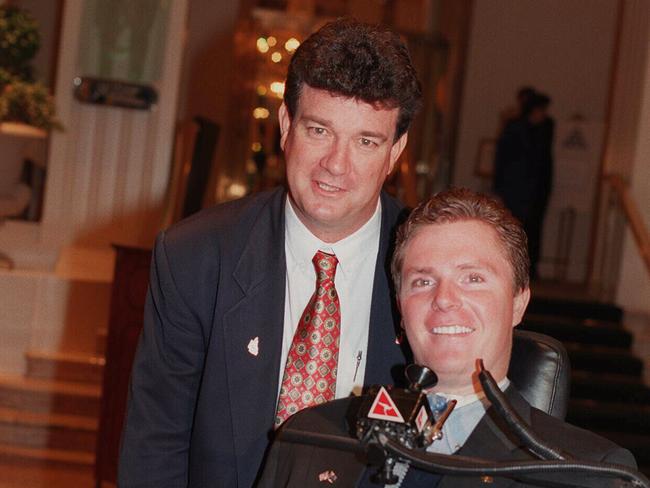
“I was just 19 when the accident happened so I still lived with my parents,” he says.
“Mum still lives on the Coast but my dad lives on Magnetic Island. They split up after the accident. It’s not uncommon. All of my mother’s attention was caught up on me and my needs and the marriage suffered.
“I lived with my sister for a while and now my brother, but I don’t want to be their burden.
“I’m so lucky to have had their support all this time, as well as my friends. Even as we sit here, my phone keeps ringing with friends who are helping me out. I’m lucky some of my friends are developers,” he laughs.
In fact, the chairman of the Perry Cross Spinal Foundation is his old TSS classmate and rugby teammate Tom Ray, executive director of the Ray Group.
In just a few weeks, both Perry and Tom will be reunited with the rugby team from that fateful day in 1994.
Together they’ll gather to watch the Wallabies play Argentina at Robina’s Cbus Super Stadium on September 15. Their former captain, Nathan Grey, is now the national team’s assistant coach.
“I still stay in close contact with quite a few from the team,” says Perry.
“It was a day that changed us all, I guess.
“I know one of the guys from the other team who was in that ruck. He still suffers trauma from it.
“It wasn’t his fault, it wasn’t the game’s fault, it wasn’t my fault. It’s just one of those things.
“I frequently talk to parents and kids and tell them to get involved in rugby. What happened to me is the exception. But what happens when you play sport — the fitness, the camaraderie, the fun — that’s common.”
It’s not the first time the team have shown their support for Perry, with Grey raising eyebrows among the Wallabies for his regular participation in Sipweek.
The campaign, which raises money for the Spinal Research Foundation, sees participants consume all liquids through a straw to gain insight into how difficult life is for people with paralysis.
It’s an initiative that has taken on new importance, given the current campaign to ban plastic straws.
“I totally understand the environmental reasons why disposable plastic straws should not be common place,” says Perry.
“But I think it’s important too that we don’t forget how many people there are with disabilities who need straws to survive.
“One of the most difficult aspects about being disabled is just how frequently you are overlooked. It’s not out of spite or lack of caring, we’re just forgotten.
“One out of six Australians has a disability. There are a lot of us. Obviously not everyone is like me in a wheelchair on life support, but that’s all the more reason they are overlooked.
“When we campaign for accessibility, we’re not trying to be difficult. We just want to be part of the world. Don’t leave us out.”
Perry says although most new developments on the Gold Coast cater for wheelchairs, getting around older parts of the city can be extremely difficult.
While there are no-go zones for him in the city, he says he still loves every inch of it.
It’s one of the reasons he’s so excited to see his home host the groundbreaking spinal cord research trials.
GET A NEW SET OF HEADPHONES WITH YOUR DIGITAL SUBSCRIPTION
“This city gets a bad rap for being superficial but underneath the glitz, it has the hugest heart. And also some of the biggest minds,” he says.
“It’s the combination of both that’s going to make this trial a success. I have been held up and supported by this community for 24 years now. I love it. And I miss it. I wish I could be back in the ocean, I wish I could get back on the sand.
“I’ve been watching from the foreshore for over two decades now. I’m not complaining, but I am dreaming of something more. Of diving back in.”
Walking away from Perry Cross, it’s impossible not to believe that anything is possible.
It’s impossible too to ignore the everyday miracle of strong legs carrying your weight, the warmth of sunlight on skin, the independence of standing on your own two feet.
Walking away from Perry Cross is a lesson in gratitude.

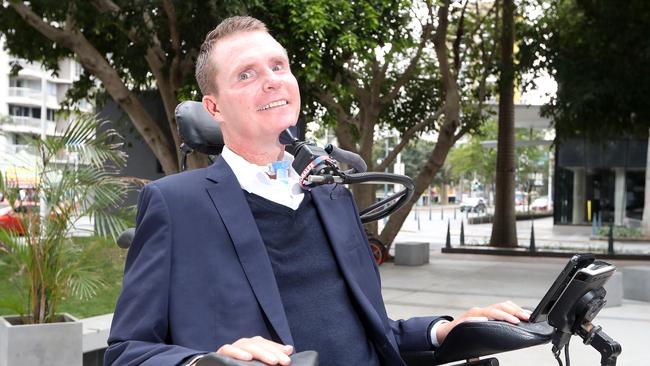
Add your comment to this story
To join the conversation, please log in. Don't have an account? Register
Join the conversation, you are commenting as Logout
Revealed: All Coast’s options for solving gridlock nightmare
The Gold Coast's population will surge by 350,000 in two decades, but the city's transport blueprint remains in limbo after light rail's dramatic cancellation. FIND OUT MORE
Big brother vs little brother: Inside the bitter Suns v Lions rivalry
Fourteen years after stunning Brisbane in their first encounter, the Gold Coast Suns return to the Gabba hunting another miracle in tonight’s historic finals clash.